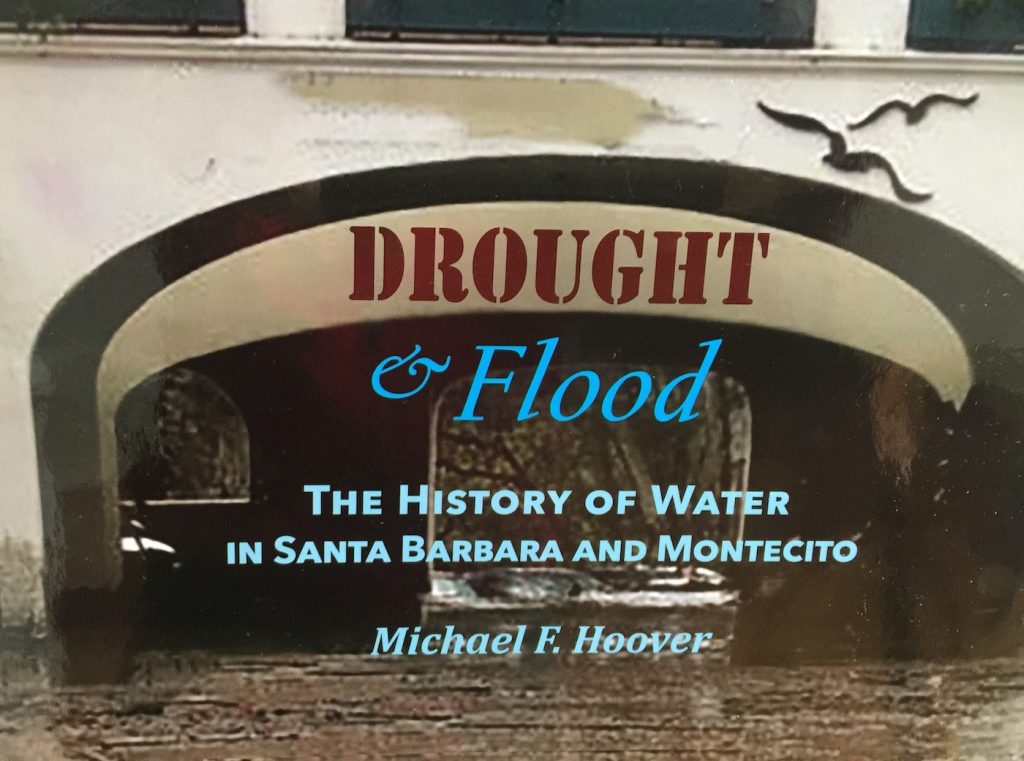Drought & Flood

I’ve lived in Montecito – in the same house – for over 35 years and find it necessary to point out to folks just moving here that while we live in a beautiful place, ensconced as we are between the 4,000-ft Figueroa Mountains and the deep blue Pacific Ocean, it isn’t perfect. Add a near-ideal year-round climate, a few thousand really nice homes, two elementary schools that rank near the top in the state and boast of seriously high-achieving students and, well, it’s a nifty place to live, all in all.
However, those mountains and dense dry foliage behind us and the Pacific Ocean in front (or vice versa, depending upon your point of view), have, from time to time, caused any number of calamities and near disasters, the most recent being, of course, the mud and debris flow that took 23 lives in 2018 and destroyed and/or seriously damaged as many as 400 homes. Before the debris flow, the Thomas Fire – at the time (2017) California’s largest; it still numbers in the top five – nearly wiped out the entire village, if not for the serindipitous doubling up of one group of 300 firetrucks about to replace another 300 firetrucks at precisely 7 am on a Saturday morning just as 30mph+ winds were whipping up 40-ft flames that seemed intent on rushing into Montecito proper. The virtual army of firefighters and their equipment in the hills above us were so abundant that firetrucks were able to station themselves at individual homes as embers landed on their roofs, thereby saving Montecito.
Again.
We had major flooding in the winter of 1995/96, again in 1998 (and 1967, 1983, etc., but I didn’t live here then), and of course many instances of both wildfire and floods going back as far as history allows.
So, Michael F. Hoover’s (with David Wilk) recently published Drought & Flood, The History of Water in Santa Barbara and Montecito, isa book you as a homeowner should not only read but should also add to your library.
Even though pretty much everything that could burn did burn in the Thomas Fire and we really don’t have to worry about forest fire for perhaps as many as fifteen years, flood waters are likely to recur any time we get a 7-inch+ rainfall in a short period of time, say 24 or 48 hours. Currently, our creeks are clear, steel nets are in place above creeks in half-a-dozen strategic spots, and debris basins have been deepened and added to.
So, we’re in good shape.
But, Mr. Hoover, who writes like an engineer because he is a (water) engineer, goes back millions of years and describes events that have actually created Montecito and Santa Barbara. I say he “writes like an engineer,” and mean no disrespect. In fact, his book reads like a thriller that could have been written by, say, one of the astronauts on the failed Apollo Mission 13. Listening to those men – engineers all, I’d say – speak laconically of their mortal predicament as they calmly and deliberately discuss ways of engineering their hobbled space craft back to Earth is absolutely thrilling. Drought & Flood presents its informative evidence of turmoil in the same way. Words such as “devastation,” “horrific,” or phrases like “the coming disaster,” and others are dispensed with as hyperbole by the authors.
Instead, they methodically and calmly narrate the tale of decades-long droughts, wildfires, flooding of Biblical dimensions, and of enormous debris flows that helped create both Montecito and the entire Santa Barbara area.
Chapters cover everything from geologic history, the Chumash, the Spanish presence, the Franciscan water system (still in evidence up behind the Santa Barbara Old Mission). Messrs. Hoover and Wilk recount The Great Drought of 1863 that required the massacre of herds of cattle for lack of drinking water (and gave the name Shark’s Cove to the shallow area just offshore; the carcasses dumped in the ocean there and attracted a great number of sharks).
You’ll read of regular flooding in California, “atmospheric storms,” and the “Pineapple Express,” which is a flow of moisture from Hawaii that is drawn in and converges with a low pressure system from Alaska, creating an “atmospheric river” of precipitation and, frequently resulting in flooding.
You’ll read of the building of Gibraltar Dam, Juncal Dam, and the Cachuma Project as Santa Barbara and Montecito attempted to ensure a sufficient supply of water for their residents. You’ll also read of horizontal wells, water tunnels, cisterns, the development of private water companies, state water, desalination, and much more, closing with prognostications on the future of water in Santa Barbara.
Drought & Flood is an easy and enjoyable read. It’s also comprehensive; you’ll learn more about the geologic formation of this area than you possibly ever imagined knowing. The illustrations, maps, and charts are clear and informative.
I set aside a long and rainy weekend afternoon and settled in to read this wonderful little tome and have since added it to my own library of local literature that includes David Myrick’s three-volume Santa Barbara & Montecito, along with Walker A. Tompkins’ colorful treatises, Erin Graffy’s clever How To Santa Barbara, books, and a few others.
I do believe both Tecolote Book Shop in Montecito and Chaucer’s at Loreto Plaza in Santa Barbara carry it, and at $20 a pop, it’s a steal. •MJ







You must be logged in to post a comment.